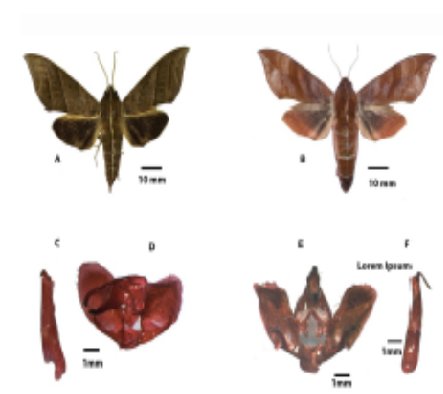


Indian Journal of Science and Technology
DOI: 10.17485/IJST/v16sp1.msc8
Year: 2023, Volume: 16, Issue: Special Issue 1, Pages: 57-61
Original Article
Lalruatthara Hmar1,2, B Lalnghahpuii1, Samuel Lalronunga1,2, Lalramliana1,3, John Zothanzama2,4, Lalthanpuii5, Esther Lalhmingliani1,2*
1Systematics and Toxicology Laboratory, Department of Zoology, Mizoram University, Aizawl, 796004, Mizoram, India
2Natural History Museum of Mizoram, Mizoram University, Aizawl, 796004, Mizoram, India
3Department of Zoology, Pachhunga University College, Aizawl, 796005, Mizoram, India
4Department of Biotechnology, Mizoram University, Aizawl, 796004, Mizoram, India
5Department of Botany, Government Zirtiri Residential Science College, Aizawl, 796014, Mizoram, India
*Corresponding Author
Email: [email protected]
Received Date:23 January 2023, Accepted Date:09 June 2023, Published Date:30 July 2023
Background/Objectives: Sphingidae are a family of moths belonging to the order Lepidoptera, commonly known as hawk moths or Sphinx moth, named for their hovering, streamlined shape and narrow wings. The current study deals with a detailed description of two species of sphingid moth belonging to the genus Ampelophaga: A. rubiginosa and A. dolichoides from Mizoram, North-east India. Methods: Sphingid moths were collected using light trapping method. A white sheet of cloth was hung vertically between two poles and a mercury vapour lamp (160W) as a light source and HondaTM EP1000 portable generator serves as a power source. Moths attracted to light were hand sampled, and killed using petroleum ether. Collected specimens were stored in butter paper with wings folded vertically. Identification and genitalia dissection was done in the Systematics and Toxicology Laboratory, Department of Zoology, Mizoram University. Findings: From our study we observed that A. dolichoides were more prevalent than A. rubiginosa and were found to inhabit much lower elevation whereas A. rubiginosa were found only in the ranges above 600m asl. Though extensive literature survey showed that A. rubiginosa usually occurs between 1200m and 2200m altitude, the current study documented that A. rubiginosa were also found to occur in altitudinal range between 600m-900m asl thereby extending their previously known altitudinal range. Novelty: Extensive survey of literature yielded no reports on the genus Ampelophaga in Mizoram. The study reported two species of the genus Ampelophaga for the first time from Mizoram with notes on their morphological attributes. This study will add to the diversity of sphingid moth of Mizoram and India as well.
Keywords: Sphingidae; Mizoram; Taxonomy; Ampelophaga; Diversity
© 2023 Hmar et al. This is an open-access article distributed under the terms of the Creative Commons Attribution License, which permits unrestricted use, distribution, and reproduction in any medium, provided the original author and source are credited. Published By Indian Society for Education and Environment (iSee)
Subscribe now for latest articles and news.